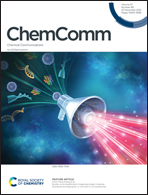Insights into the mechanism and regioselectivity in Ni-catalysed redox-relay migratory hydroarylation of alkenes with arylborons†
Abstract
DFT studies reveal that Ni-catalysed redox-relay hydroarylation of alkenes occurs via concerted hydronickelation, iterative β-H elimination/migratory insertion and reductive elimination to yield the α-substituted product. The driving force for the redox-relay migratory hydroarylation arises from the stability of the LArNi(II)CHPhPr intermediate, which only allows its C–C elimination pathway to be opened up.



 Please wait while we load your content...
Please wait while we load your content...